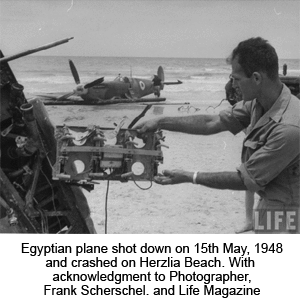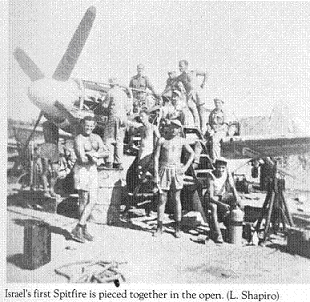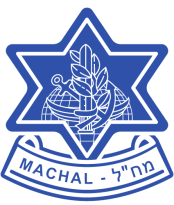 The State of Israel was declared by David Ben-Gurion on 14th May, 1948. On 15th May, whilst doing a low-level attack on Sde Dov airfield in Tel Aviv, a Spitfire of the Royal Egyptian Air Force (REAF) was shot down by Sam Rose, a British Machalnik manning a machine-gun, and the Spitfire crashed on the Herzlia beach.
The State of Israel was declared by David Ben-Gurion on 14th May, 1948. On 15th May, whilst doing a low-level attack on Sde Dov airfield in Tel Aviv, a Spitfire of the Royal Egyptian Air Force (REAF) was shot down by Sam Rose, a British Machalnik manning a machine-gun, and the Spitfire crashed on the Herzlia beach.
Egyptian plane shot down on 15th May, 1948 and crashed on Herzlia Beach.
With acknowledgment to photographer Frank Scherschel and Life Magazine
On 22nd May, the REAF attacked Ramat David air base which was still occupied by the Royal Air Force (RAF) on the mistaken assumption that the Israel Air Force had already taken over the base, and in the attack the Egyptian Air Force destroyed and damaged a number of Royal Air Force Spitfires parked on the ground. In a second attack on the base, the REAF destroyed a Dakota C-47 and a hangar, and killed four RAF personnel. When a formation of five Egyptian Spitfires returned for a third attack, the RAF which was then on the ready shot down the entire formation of the five Egyptian Spitfires.
The IAF built its first Spitfire from “junk” which was left by the RAF when the British forces evacuated Palestine, as well as from components from the six REAF Spitfires (referred to above) which had been shot down. On 23rd July 1948, the IAF’s first reconstructed Spitfire was test-flown by Boris Senior, a South African Machalnik. The Spitfire was flown from the Herzlia airfield to a landing strip at Ma’abarot, and became operational in August 1948. A second Egyptian Spitfire was also reconstructed from RAF junk and from components of the Spitfires which had been shot down, and was test-flown on 14th October by Morrie Mann (a British Machalnik). This aircraft became operational on 21st October. During “Operation Horev” in December 1948, one Egyptian Spitfire was captured intact at the REAF’s El-Arish air base in the Gaza Strip.

VELVETTA I
In August 1948, Czechoslovakia sold 50 Spitfires to Israel at a cost of $23,000 per aircraft. The aircraft were to be dismantled so as to be airlifted by C-46 and C-54 transport aircraft from Czechoslovakia to Israel. However, political pressure from the U.S. and Britain stopped the air-bridge from Czechoslovakia to Israel in August 1948, and so the only solution was to fly the Spitfires from Czechoslovakia to Israel, with only one single refueling stop at Niksic in Southern Yugoslavia. The leg from Czechoslovakia to Niksic was 500 kilometers, but the distance from Niksic to Israel was about 1,200 miles (1,900 kilometers). Sam Pomerance, an American Machalnik and a very outstanding pilot/engineer, together with Jack Cohen (a South African pilot), Bob Dawn (a Canadian master mechanic), Norman Novak (an American flight engineer), and a unit of Czech ground crews, made up the team for preparing the Spitfires for this daunting flight. In order to lighten the Spitfires considerably, the aircraft were stripped of their guns and cannons, armor-plating, oxygen cylinders, cameras, and radios. Fuel tanks were fitted onto the bomb racks under each wing, and a long-range tank under the belly, and another tank in the space in which the radio had been located. All these fuel modifications increased the fuel capacity from a normal 85 gallons to 379 gallons (606 liters). Under the command of Boris Senior, a South African Machalnik, Leslie Shagam (also a South African Machalnik) was appointed to organize the Velvetta Operation flights from Czechoslovakia to Yugoslavia, and from Yugoslavia to Israel. On 24th September 1948, the first six Spitfires were flown to Yugoslavia from Czechoslovakia, but one of the aircraft was damaged on landing. On 27th September, the five remaining Spitfires took off for Israel. A C-54 was the “mother ship” which would navigate and monitor the flight. Another C-46 equipped with dinghies served as an air-sea-rescue aircraft in case one of the pilots was forced to ditch his aircraft whilst flying over the sea. Also, as an extra precaution, a naval vessel patrolled the route, and as the formation neared the coast of Israel, two Avia S-199 fighters were on standby to protect the unarmed formation in case of intervention by the Egyptian Air Force.
The five pilots on the flight from Yugoslavia to Israel were Jack Cohen, Syd Cohen, Boris Senior, Modi Alon, and Sam Pomerance leading the formation. After two hours in flight, Boris Senior and Modi Alon had problems with their fuel systems, and the mother ship instructed them to land at a Greek air force base on Rhodes Island. Both pilots were arrested as suspected Communist sympathizers, and the Spitfires were impounded. Following intervention by the Haganah the two pilots were released on 12th October, but the aircraft remained impounded. The remaining three Spitfires arrived safely in Israel, with only drops of fuel left in their tanks after a 5-hour-and-20 minutes flight. On arrival, the Spitfires were immediately integrated into 101 Squadron which until then had been flying the Avia-199s, the IAF’s first combat aircraft.
VELVETTA II
By mid-December 1948, 15 additional Spitfires were ready for delivery. On 18th December, six Spitfires led by Sam Pomerance left for Yugoslavia, but due to a very severe snow storm the aircraft were forced to turn back. Two Spitfires were lost as a result of the storm. Sam Pomerance, who had orchestrated the Velvetta Operations, was killed when he crashed into a mountain during the storm, and the second pilot, Bill Pomerantz, survived his crash – landing on a beach.
On 19th December, six aircraft flew to Yugoslavia, to be followed by six more aircraft on 20th December, and four more on 23rd December. The last batch of six Spitfires left on 26th December. These formations of Spitfires were also led from Yugoslavia to Israel by C-46 “mother ships.” Two Spitfires which had to be left behind in Czechoslovakia due to mechanical problems were disassembled and crated and transported in two C-46 aircraft, arriving in Israel on 28th December. Except for the tragic death of Sam Pomerance and the loss of two Spitfires due to the snow storm, Velvetta II was a smashing success. With this massive reinforcement of combat aircraft, the IAF very quickly established complete air superiority over the battle zones.
AIR OPERATIONS
At the time of “Operation Yoav” in October 1948, which captured Beersheba from the Egyptians and consolidated the Negev, only four Spitfires and two P-51s were operational. They were engaged in multiple operations – escorting B-17 and Beaufighter bombers, supporting ground forces, flying air patrols and air reconnaissance. On 15th October 1948, the first day of “Operation Yoav,” Rudy Augarten, Syd Cohen, and Jack Cohen, each one flying a Spitfire, made a tremendously successful attack on the El-Arish air base, destroying several Egyptian aircraft on the ground and in their hangars, and putting the airfield temporarily out of action. This was an example of an excellent low-flying attack. The Spitfires also participated in “Operation Hiram” which had liberated the Galilee.
On 9th November, 101 Squadron moved from Herzlia to the Hatzor air base so as to be closer to the battle zone for action against the Egyptians. Prior to “Operation Horev,” which was launched towards the end of December, 10 Velvetta II Spitfires had arrived in Israel, but not all the planes were serviceable because of technical problems. In addition to attacking Egyptian ground forces and air bases, as well as escorting B-17s, Beaufighters, Harvards and C-46s, 101 Squadron was shooting down and damaging enemy aircraft.
ROYAL EGYPTIAN AIR FORCE SPITFIRES
The Royal Egyptian Air Force was the main adversary of the Israel Air Force in the War of Independence. In 1945 the British supplied 21 Spitfires to the Egyptian Air Force, and an additional 41 Spitfires during 1946 and 1947. All the Egyptian Air Force Spitfires operated from the Egyptian front-line air bases at El-Arish and El-Hama. The Egyptian Spitfires had more success against the Israelis on the ground than in the air. Until the Israel Air Force received its Spitfires under Velvetta I and Velvetta II, the Egyptian Spitfires vigorously strafed and bombed Israeli civilian and military targets. However, with the arrival of the Spitfires from Czechoslovakia, control of the skies shifted from the Egyptian Air Force to the Israel Air Force. It is estimated that the Royal Egyptian Air Force lost 18 Spitfires and at least 9 Fiats/Macchis as a result of air combat and ground attacks. It is indeed ironic that the first two Spitfires of the Israel Air Force were constructed from junk left by the RAF and from components of downed Egyptian Spitfires – mainly engines, guns, and radios.
CLASHING WITH THE RAF
The cease-fire between the Israelis and Egyptian Forces was due to take effect at 4 p.m on 7th January 1949, and would halt hostilities in the War of Independence. In the morning of 7th January, the RAF sent four Spitfires on a low-level reconnaissance mission over the battle front. Prior to the arrival of these RAF aircraft, Israeli ground forces had been heavily attacked by the Royal Egyptian Air Force, and three armored trucks were on fire. An Israeli tank, one of those stolen from the British Army and manned by a Machal crew, shot one of the four RAF Spitfires down. At that very time, two IAF Spitfires from 101 Squadron which were on patrol in the area saw this commotion on the ground, and the other three Spitfires in the area. The Israeli Spitfires engaged the RAF Spitfires, mistaking them for REAF planes, and in a short air battle, Canadian Machalnik John McElroy shot down two RAF Spitfires, and U.S. Machalnik Slick Goodlin shot down the remaining Spitfire. Later on in the morning, when a second pair of 101 Squadron Spitfires piloted by U.S. Machalnik Denny Wilson and South African Machalnik Arnie Ruch were patrolling the battle zone, they encountered eight REAF Macchis. Wilson engaged five Macchis, and although his plane was hit he returned safely to Hatzor air base. Then, later in the day, four 101 Squadron Spitfires led by Ezer Weizman engaged a formation of 19 British aircraft – 4 Spitfires and 15 Tempests, which had been dispatched from the Suez Canal zone to look for the 4 missing RAF Spitfires. Bill Schroeder shot down one Tempest, and Ezer Weizman damaged a second Tempest but didn’t shoot it down. The IAF then decided to disengage, and so this was the last combat operation of the IAF’s Spitfires in the War of Independence.
101 SQUADRON’S SCORE CARD OF ENEMY AIRCRAFT SHOT DOWN OR DAMAGED (“Kill” means Enemy aircraft destroyed)
| Date | Pilot | 101’s Aircraft | Enemy Aircraft | Remarks |
| 1948 | ||||
| 3rd June | Modi Alon | S-199 | Egyptian C-47 | Kill |
| 3rd June | Modi Alon | S-199 | Egyptian C-47 | Kill |
| June | Giddy Lichtman | Egyptian Spitfire | No official documentation. Squadron record only. |
|
| 10th July | Maurice Mann | S-199 | Syrian Harvard | Kill |
| 18th July | Modi Alon | S-199 | Egyptian Spitfire | Kill |
| 23rd September | Giddy Lichtman | S-199 | Jordanian Rapide | Kill |
| 16th October | Rudy Augarten | S-199 | Egyptian Spitfire | Kill |
| 21st October | Rudy Augarten | Spitfire | Egyptian Spitfire | Kill |
| 4th November | Rudy Augarten | Mustang P-51 | Egyptian C-47 | Kill shared with Boris Senior |
| 4th November | Boris Senior | Mustang P51 | Egyptian C-47 | Kill shared with Rudy Augarten |
| 17th November | Rudy Augarten | Spitfire | Egyptian Spitfire | Kill |
| 20th November | Wayne Peake | Mustang P-51 | British Mosquito | Kill – Mosquito doing photo reconnaissance over Hatzor airbase |
| 22nd December | Rudy Augarten | Spitfire | Egyptian Fiat | Damaged Fiat at El-Arish airbase |
| 28th December | Gordon Levett | Spitfire | Egyptian Fiat | Kill |
| 28th December | Gordon Levett | Spitfire | Egyptian Spitfire | Kill |
| 28th December | Jack Doyle | Spitfire | Egyptian Fiat | Kill |
| 30th December | Jack Doyle | Spitfire | Egyptian Fiat | Kill |
| 30th December | John McElroy | Spitfire | Egyptian Fiat | Kill |
| 31st December | John McElroy | Spitfire | Egyptian Fiat | Kill |
| 31st December | Denny Wilson | Spitfire | Egyptian Fiat | Kill |
| 1949 | ||||
| 5th January | Seymour Feldman | Spitfire | Egyptian Fiat | Kill |
| 5th January | Boris Senior | P-51 | Egyptian Fiat | Kill |
| 7th January | John McElroy | Spitfire | 2 British Spitfires | 2 Kills |
| 7th January | Slick Goodlin | Spitfire | British Spitfire | Kill |
| 7th January | Bill Schroeder | Spitfire | British Tempest | Kill |
| 7th January | Jack Doyle | P-51 | Egyptian Fiat | Kill |
| 7th January | Boris Senior | P-51 Mustang | Egyptian Fiat | Kill |
101 Squadron’s score card showed 24 enemy aircraft were shot down from the air – 16 Egyptian aircraft, 5 British, 1 Syrian, and 1 Jordanian; 6 aircraft were damaged – 5 Egyptian and 1 British. The breakdown of aircraft destroyed included 9 Macchis, 5 Spitfires, 3 C-47s, 1 Tempest, 1 Mosquito, 1 Harvard, and 1 Dragon Rapide. Several Egyptian aircraft were destroyed on the ground when the Egyptian air bases were attacked at El-Arish and El-Hama.
The top-scoring pilots were: John McElroy 4; Rudy Augarten 3.5; Modi Alon 3; Jack Doyle 3; Boris Senior 2.5; Gordon Levett 2, and 7 pilots had 1 kill each.
CONCLUSION
The famous Spitfire, an icon of World War II, played a decisive role in the War of Independence. Three Air Forces flying Spitfires were engaged – the Israel Air Force, the Royal Egyptian Air Force, and the Royal Air Force. When Israel acquired its Spitfires, the IAF rapidly established complete air superiority, and there can be no doubt that the IAF’s Spitfires played a crucial part in Israel’s victory in the War of Independence, which on 7th January 1949, ended over the barren desert of Sinai on such a dramatic and memorable note.

